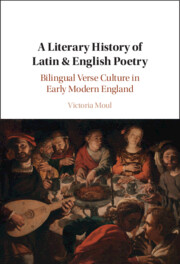Book contents
- A Literary History of Latin & English Poetry
- A Literary History of Latin & English Poetry
- Copyright page
- Dedication
- Contents
- Figures
- Acknowledgements
- Abbreviations
- Introduction
- Part I Shorter Verse
- Chapter 1 Anglo-Latin ‘Moralizing Lyric’ in Early Modern England
- Chapter 2 Metrical Variety and the Development of Latin Lyric Poetry in the Latter Sixteenth Century
- Chapter 3 Buchanan, Beza and the Genre of the Sidney Psalter
- Chapter 4 Formal Panegyric Lyric in England, 1550–1650
- Chapter 5 Abraham Cowley and Formal Innovation
- Chapter 6 Religious and Devotional Epigram and Lyric
- Chapter 7 Epigram Culture and Literary Bilingualism in Early Modern England
- Chapter 8 Satire, Invective and Humorous Verse
- Part II Longer Verse
- Afterword
- Metrical Appendix: Latin Metres
- Bibliography A: Manuscripts
- Bibliography B: Early Printed Books
- Bibliography C: Secondary Literature
- Index
Chapter 1 - Anglo-Latin ‘Moralizing Lyric’ in Early Modern England
from Part I - Shorter Verse
Published online by Cambridge University Press: 23 June 2022
- A Literary History of Latin & English Poetry
- A Literary History of Latin & English Poetry
- Copyright page
- Dedication
- Contents
- Figures
- Acknowledgements
- Abbreviations
- Introduction
- Part I Shorter Verse
- Chapter 1 Anglo-Latin ‘Moralizing Lyric’ in Early Modern England
- Chapter 2 Metrical Variety and the Development of Latin Lyric Poetry in the Latter Sixteenth Century
- Chapter 3 Buchanan, Beza and the Genre of the Sidney Psalter
- Chapter 4 Formal Panegyric Lyric in England, 1550–1650
- Chapter 5 Abraham Cowley and Formal Innovation
- Chapter 6 Religious and Devotional Epigram and Lyric
- Chapter 7 Epigram Culture and Literary Bilingualism in Early Modern England
- Chapter 8 Satire, Invective and Humorous Verse
- Part II Longer Verse
- Afterword
- Metrical Appendix: Latin Metres
- Bibliography A: Manuscripts
- Bibliography B: Early Printed Books
- Bibliography C: Secondary Literature
- Index
Summary
Unlike some ofthe poetic forms discussed in subsequent chapters, which have a discernible ‘vogue’ and then fall out of fashion, the 'moralizing lyric'was consistently popular throughout the whole of the period covered by this book, and several are among the most widely circulated poems of early modernity. Key examples, composed between the 1530s and the early eighteenth century, from Wyatt to Watts (and indeed well beyond that, far beyond the scope of this book), recognizably belong together. But this most ostensibly English of forms has its roots in the translation and imitation of classical poetry, and emerged in the sixteenth century in both Latin and English, with influence moving in both directions. As a starting point for this book, it demonstrates what can be learnt by a serious attention to literary bilingualism: repeatedly, it is the Latin versions , including translations of the best-known English examples into Latin, which point to the classical texts (especially Horace, Seneca and Boethius) that underpin these poems, and the (broadly) Latin lyric context to which they were understood to belong by contemporary readers.
Keywords
- Type
- Chapter
- Information
- A Literary History of Latin & English PoetryBilingual Verse Culture in Early Modern England, pp. 25 - 67Publisher: Cambridge University PressPrint publication year: 2022

